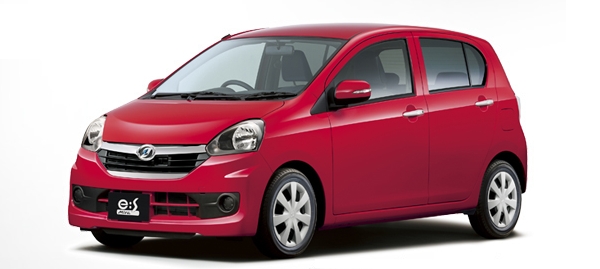|
|
|
Published
on 14
Nov 2014
|
All rights reserved.
|
|
|
The development of
K-cars is sometimes as disappointing as the economy of Japan. When the
economy has no hope of full recovery, car market continues to shrink
and all players have to focus on cutting costs rather than innovating
new technologies or upgrading quality. Daihatsu Mira e:S is a good
example. Traditionally, Mira is the bread-and-butter K-car of Daihatsu.
Compared with siblings Move and Tanto it is leaner and far more
conventional, thus it is sold as the company’s entry-level model.
However, cheap to buy alone is no longer enough to win sales these
days. Cheap to run is equally important. When the current generation
Mira was launched in late 2011, it strived to become the most
economical K-car on the market. Thanks to a batch of fuel-saving
technologies dubbed e:S, which stands for Eco & Smart – or
Daihatsu’s version of Skyactiv – it succeeded to cut fuel consumption
by almost 40 percent. In Japanese cycle JC08 terms it means 30 km per
liter, an unprecedented value for non-hybrid petrol cars. Moreover,
over the years this was improved further to 35.2 km/liter to maintain
its lead against rivals which followed suit to pursue high fuel
efficiency. Fuel economy becomes the sole selling point of Mira, sadly.
How does the e:S achieve the efficiency gains? Firstly, engineers
worked hard to cut fat and lighten the car. All panels and components
were evaluated for potential of weight saving. The body shell switched
to thinner steel panels and was lightened in places to cut about 30 kg.
The interior got thinner plastic panels, thinner seat frames and less
sound insulation. The CVT housing was lightened, while oil pump cover
was converted to aluminum. In the process it shaved 60 kg from the kerb
weight while managed to reduce material costs. Secondly, aerodynamic
drag was reduced by employing a prominent air dam, underbody panels and
deflectors around rear wheels. Thirdly, mechanical friction was reduced
thanks to using low-rolling resistance tires and smaller bearings.
Fourthly, engine efficiency was improved. The cheap K-car could not
afford direct-injection, of course, but some cheaper technologies still
help, such as cooled exhaust gas recirculation, low-friction chains,
improved fuel injection and a slightly higher compression ratio. More
recently, the 660 c.c. triple has been converted to run Atkinson cycle
to improve thermal efficiency further. This is easily implemented by
utilizing the existing VVT to delay the closure of intake valves.
Fifthly, the e:S gets not only a standard automatic engine stop-start
feature but also has it set to work for a wider range. Lastly but not
least, the CVT on this car uses lower ratios and “lazier” strategy to
keep the engine running at lower rev more the time.

Mira e:S (2014)
|
However, these changes do have some drawbacks. First to be hit is
performance. Remember the last generation engine produced 58 ps in
naturally aspirated form? The new car managed only 52 ps on debut, and
this drops further to 49 ps in the recent conversion to Atkinson cycle.
Torque delivery suffers as well, dropping from 48 lbft on the old car
to 42 lbft today. Moreover, the arrival of peak torque is delayed from
4000 rpm to 5200 rpm. In low-speed urban driving the difference might
not be too obvious, but whenever you want to overtake slower cars or go
uphill, you will need to rev the motor incredibly hard, which is noisy.
Speaking of noise, the cabin with thinner plastic panels and insulation
makes it harder to conceal noise sources of all kinds, no matter the
engine drone, CVT whine or tire roar. The result is an unrefined
driving experience. As for ride and handling, it is typical K-car, i.e.
easy to steer but rolls a lot in corners, generates little grip and
feels hardly sporty. Ride comfort is somewhat hampered by the high tire
pressure deliberately chosen to achieve low rolling resistance. Even by
K-car standards, its ride and handling is mediocre.
Worse still, the Mira e:S is equally mediocre in exterior and interior
design. The styling is dull, while perceived quality is quite poor. The
thin door panels sound hollow and feel fragile. Seats and equipment are
quite Spartan, although space is abundant. Everywhere reminds you this
is a basic transport. There is no fun to speak of.
|
Verdict:   |
|
|
|
|
|
|
|
|
|
|
Mira e:S
|
2011
(2014 spec. shown)
|
Front-engined,
FWD
|
| Steel monocoque |
Mainly steel
|
| 3395 / 1475 / 1490 mm |
| 2455 mm |
Inline-3, Atkinson cycle.
|
| 658 cc |
DOHC 12 valves, DVVT
|
| - |
-
|
49 hp / 6800 rpm
|
42 lbft / 5200 rpm
|
CVT
|
F: strut
R: torsion-beam
|
-
|
155/65SR14
|
730 kg
|
-
|
-
|
-
|
|
|
|
|
|
|
|
Performance
tested by: -
|
|
|
|
|
|
|
|
|
Copyright©
1997-2014
by Mark Wan @ AutoZine
|
|